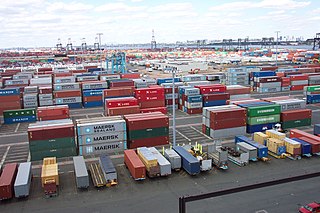
A ship is a large vessel that travels the world's oceans and other navigable waterways, carrying cargo or passengers, or in support of specialized missions, such as defense, research and fishing. Ships are generally distinguished from boats, based on size, shape, load capacity and purpose. Ships have supported exploration, trade, warfare, migration, colonization, and science. Ship transport is responsible for the largest portion of world commerce.

Freight transport, also referred as freight forwarding, is the physical process of transporting commodities and merchandise goods and cargo. The term shipping originally referred to transport by sea but in American English, it has been extended to refer to transport by land or air as well. "Logistics", a term borrowed from the military environment, is also used in the same sense.

Maritime transport or more generally waterborne transport, is the transport of people (passengers) or goods (cargo) via waterways. Freight transport by sea has been widely used throughout recorded history. The advent of aviation has diminished the importance of sea travel for passengers, though it is still popular for short trips and pleasure cruises. Transport by water is cheaper than transport by air or ground, but significantly slower for longer distances. Maritime transport accounts for roughly 80% of international trade, according to UNCTAD in 2020.

Containerization is a system of intermodal freight transport using intermodal containers. Containerization, also referred as container stuffing or container loading, is the process of unitization of cargoes in exports. Containerization is the predominant form of unitization of export cargoes, as opposed to other systems such as the barge system or palletization. The containers have standardized dimensions. They can be loaded and unloaded, stacked, transported efficiently over long distances, and transferred from one mode of transport to another—container ships, rail transport flatcars, and semi-trailer trucks—without being opened. The handling system is mechanized so that all handling is done with cranes and special forklift trucks. All containers are numbered and tracked using computerized systems.

A port is a maritime facility comprising one or more wharves or loading areas, where ships load and discharge cargo and passengers. Although usually situated on a sea coast or estuary, ports can also be found far inland, such as Hamburg, Manchester and Duluth; these access the sea via rivers or canals. Because of their roles as ports of entry for immigrants as well as soldiers in wartime, many port cities have experienced dramatic multi-ethnic and multicultural changes throughout their histories.

A container ship is a cargo ship that carries all of its load in truck-size intermodal containers, in a technique called containerization. Container ships are a common means of commercial intermodal freight transport and now carry most seagoing non-bulk cargo.

Mitsui O.S.K. Lines is a Japanese transport company headquartered in Toranomon, Minato, Tokyo, Japan. It is one of the largest shipping companies in the world.

A cargo ship or freighter is a merchant ship that carries cargo, goods, and materials from one port to another. Thousands of cargo carriers ply the world's seas and oceans each year, handling the bulk of international trade. Cargo ships are usually specially designed for the task, often being equipped with cranes and other mechanisms to load and unload, and come in all sizes. Today, they are almost always built of welded steel, and with some exceptions generally have a life expectancy of 25 to 30 years before being scrapped.

A merchant ship, merchant vessel, trading vessel, or merchantman is a watercraft that transports cargo or carries passengers for hire. This is in contrast to pleasure craft, which are used for personal recreation, and naval ships, which are used for military purposes.

The modern terms short-sea shipping, marine highway and motorways of the sea, as well as the more historical terms coastal trade, coastal shipping, coasting trade and coastwise trade, all encompass the movement of cargo and passengers mainly by sea along a coast, without crossing an ocean.

A freight rate is a price at which a certain cargo is delivered from one point to another. The price depends on the form of the cargo, the mode of transport, the weight of the cargo, and the distance to the delivery destination. Many shipping services, especially air carriers, use dimensional weight for calculating the price, which takes into account both weight and volume of the cargo.

The lighter aboard ship (LASH) system refers to the practice of loading barges (lighters) aboard a bigger vessel for transport. It was developed in response to a need to transport lighters, a type of unpowered barge, between inland waterways separated by open seas. Lighters are typically towed or pushed around harbors, canals or rivers and cannot be relocated under their own power. The carrier ships are known variously as LASH carriers, barge carriers, kangaroo ships or lighter transport ships.

Ellerman Lines was a UK cargo and passenger shipping company that operated from the late nineteenth century and into the twentieth century. It was founded in the late 19th century, and continued to expand by acquiring smaller shipping lines until it became one of the largest shipping firms in the World. Setbacks occurred through heavy losses to its merchant fleet in the First and Second World Wars but were overcome in each case.

American Export-Isbrandtsen Lines, New York, was the leading US-flag shipping company between the U.S. east coast and the Mediterranean from 1919 to 1977, offering both cargo ship and passenger ship services, until it declared bankruptcy and was acquired by Farrell Lines of New York.

Malcolm Purcell McLean was an American businessman who invented the modern intermodal shipping container, which revolutionized transport and international trade in the second half of the twentieth century. Containerization led to a significant reduction in the cost of freight transportation by eliminating the need for repeated handling of individual pieces of cargo, and also improved reliability, reduced cargo theft, and cut inventory costs by shortening transit time. Containerization is a major driver of globalization.
The Port of Montreal is a cruise and transshipment point. It is located on the St. Lawrence River in Montreal, Québec, Canada. The port operates as an international container port. It services Toronto, the rest of Central Canada, the Midwestern United States, and the Northeastern United States. Though found on the Saint Lawrence Seaway, it is some 1,600 miles (2,600 km) inland from the Atlantic Ocean and it is on the shortest direct route between the North American Midwest and Europe or the Mediterranean.

Since 2018, transport occupied a relatively low priority in China's national development. In the twenty-five years that followed the founding of the People's Republic in 1949, China's transportation network was built into a partially modern but somewhat inefficient system. The drive to modernize the transport system, that began in 1978, required a sharp acceleration in investment. Though despite increased investment and development in the 1980s, the transport sector was strained by the rapid expansion of production and the exchange of goods.

In 1961 China established a state-run maritime shipping company and subsequently signed shipping agreements with many countries, laying the foundation for developing the country's ocean transport. That organization developed into the present-day China Ocean Shipping (Group) Company (COSCO). The Chinese government also invested heavily in water transport infrastructure, constructing new ports and rebuilding and enlarging older facilities.

The Moore-McCormack Lines was a series of companies operating as shipping lines, operated by the Moore-McCormack Company, Incorporated, later Moore-McCormack Lines, Incorporated, and simply Mooremack, founded in 1913 in New York City. It ceased trading on its buy-out in 1982. The founders were Albert V. Moore (1880–1953) (director/president) and Emmet J. McCormack (director/treasurer), with Mr Molloy (director/secretary).

The United States Marine Highway Program is a United States Department of Transportation (DOT) initiative authorized to increase use of the United States' 29,000 mi (47,000 km) of navigable waterways to alleviate traffic and wear to the nation's highways caused by tractor trailer traffic. The program is managed by the Maritime Administration's Office of Ports & Waterways Planning.




















